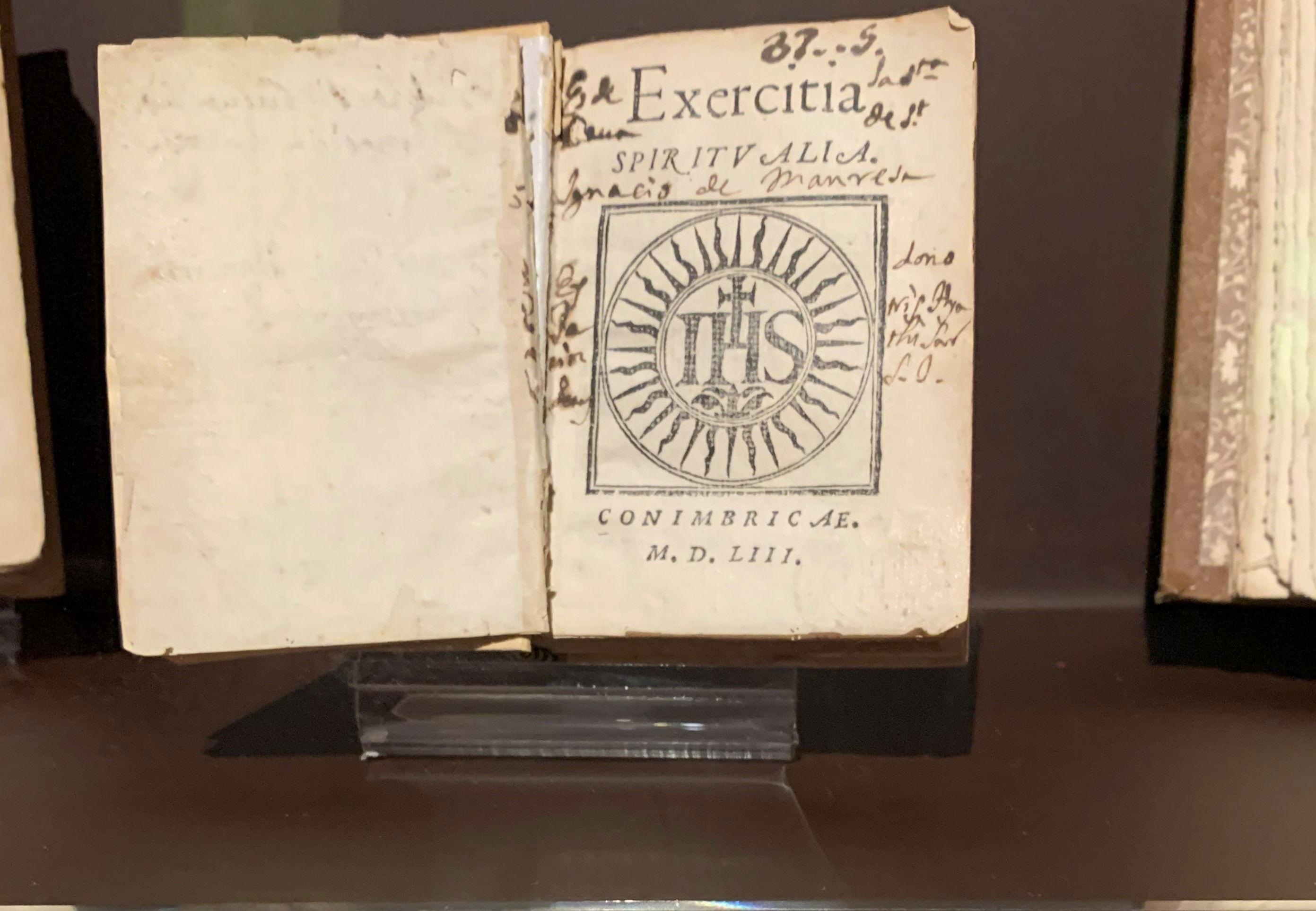WHAT ARE THE SPIRITUAL EXERCISES

First printed edition of the book of "Spiritual Exercises."
The Spiritual Exercises…flow from a life centered on the person of Jesus whose love is enacted in his incarnation, passion, death, and resurrection. It is a love that is expressed in deeds rather than mere words, and a spirituality that finds God in all things.
The structure of the Spiritual Exercises has the purpose of leading a person to true spiritual freedom. One grows into this freedom gradually. The goal of The Exercises is to free one from the habits and actions that keep one from having a relationship with God. The Spiritual Exercises are to aid a person to attain the purpose for which they were created: for the knowledge, the love, and the service of God.
The Spiritual Exercises are a manual for a four week period of meditations on the life of Jesus. It was first published in 1548. The Spiritual Exercises were the result of Ignatius’s own experience of coming to know God. The Exercises guide a pilgrim on a journey to experience their own unique, personal relationship with God.
Having been wounded and suffering from the loss of what he thought he was supposed to be, Ignatius opened himself to how he was being affected as he read the stories of the saints and Jesus. He journaled his experiences as he practiced different methods and forms of prayer. He noted how his heart was moved. He was being energized by what these new experiences were offering him in comparison to his past desire for fame. He was being formed anew. He came to develop a felt knowledge of God. He formed the experiences he had into The Spiritual Exercises. By doing so he was able to share them with others so they, too, could come to know God and God's desire for them.
Ignatian Spirituality is a way of living in relationship with God. It focuses on the desire for a union with God, with an emphasis on love and charity, and a belief in Jesus as the Son of God. Ignatian Spirituality considers everything as an important element of life and therefore one may “find God in all things”- in nature, friends, family, charitable works, prayers, religious services, music, art, etc. It is all part of spiritual life - nothing is to be hidden or feared.
So what exactly are these exercises? The Spiritual Exercises are a four week program of prayer that embodies a ‘way’ of praying on the life of Jesus. Each part has a theme. Each Theme is delved into over a certain course of time. Traditionally, the exercises have an individual withdraw from daily life for four weeks of meditation that consists of five or six prayer periods a day. This is often referred to by the Jesuits as The 30 Day Retreat or The Long Retreat. Ignatius, however, wanted as many people as possible to experience the Exercises so he included several versions or annotations to allow for flexibility in the retreat so that it may be formatted to what best serves each person. Hence, the 19th Annotation.
The Exercises are a plan that moves one on a journey of spiritual growth. The four "weeks" of themes (these are not 7 day weeks but, rather, phases of differing lengths) build upon each other. The First Week focuses on God's love for you, gratitude for the gifts God has given you in your life, as well as your own sinfulness. Even with the realization that you are a sinner or, in other words, an imperfect human being, you are loved unconditionally by God. The Second Week is based on the scripture stories of the life of the human Jesus. By meditating and/or contemplating on the stories, you are brought into contact with Jesus in an imaginary way. In The Third Week , the focus changes from Jesus’ ministry to his Passion. The Fourth Week is based on scripture readings of the Resurrection and God’s desire for you. Using the themes to guide their pilgrimage, the pilgrim practices a particular style of prayer that Ignatius often recommends: using imagination as an aid to prayer as a way of picturing yourself in a specific scripture story.
Along the spiritual journey, Ignatius introduces meditations on ideas like humility, decision making, and choosing between good and evil, as well as instructing one to contemplate scripture in an imaginative way. Ignatius shares that they are to be experienced, not read. Using one’s imagination aids your prayer experience as you picture yourself within a specific scripture story. The Exercises are not only a program of prayer but a “way” of prayer.
Experiencing the Spiritual exercises opens one to know what Ignatius referred to as a “way of proceeding” - a way to come to know and to find God in all things. This way of proceeding allows one to experience God in ordinary daily life. The Spiritual Exercises hold the understanding of the way of Ignatius: what leads to God , what creates greater freedom, and what helps one live a purposeful life.